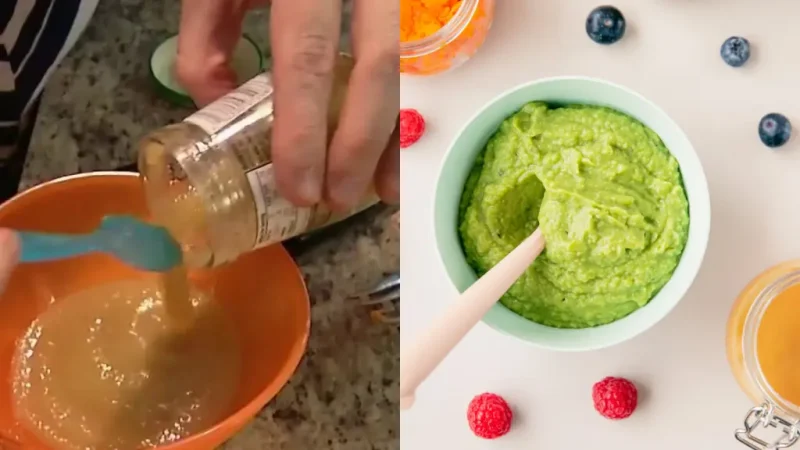Have you ever wondered why is there metal shards in baby food? Don’t worry; it’s not actual metal shards we’re talking about!
This startling question refers to heavy metals in infant nutrition, causing a stir among parents and health experts.
The truth is that fruits, vegetables, and grains can absorb heavy metals from the soil as they take in nutrients to grow. These metals then find their way into baby food products, raising concerns about potential health impacts on our little ones.

In this article, we’ll explore the reasons behind this phenomenon, discuss its implications, and discuss what parents can do to ensure their babies are getting the safest nutrition possible. Let’s unravel this mystery together!
The Shocking Discovery: Metal in Baby Food?!
Picture this: You’re lovingly spooning pureed carrots into your baby’s eager mouth, thinking about all the nutrients they’re getting. But wait! What if I told you that along with those vitamins and minerals, there might be a sprinkle of… metal?
Before you panic and toss out every jar in your pantry, let’s break this down. We’re not talking about metal shards (phew!), but something called “heavy metals.”
These sneaky substances have been found in various baby foods, and parents are scratching their heads everywhere.
What Are Heavy Metals, Anyway?
Heavy metals are naturally occurring elements found in the Earth’s crust. You might have heard of lead, arsenic, cadmium, and mercury.
Some heavy metals are essential for our health in small amounts. But too much can cause problems.
The Root of the Problem: It’s All in the Soil
Here’s the kicker: those fruits, veggies, and grains that make up your baby’s nutritious meals? They absorb heavy metals right from the soil as they grow.
They’re taking in an all-you-can-eat buffet of nutrients, and heavy metals are sneaking onto their plates!
Nature’s Sponges: How Plants Absorb Heavy Metals
Plants are incredible. They have this amazing ability to suck up nutrients from the soil through their roots.
It’s like they have tiny straws reaching into the earth, slurping up everything they need to grow big and strong.
But here’s the catch – they can’t always distinguish between good nutrients and not-so-good heavy metals.
The Soil Buffet: What’s on the Menu?
Imagine the soil as a giant buffet for plants. On the menu, we have:
- Essential nutrients (the good stuff)
- Water (can’t live without it!)
- And… heavy metals (the uninvited guests)
Plants don’t have little hands to pick and choose what they want. They take it all in, heavy metals included.
Breaking It Down: Which Foods Are Most Affected?
Some foods tend to be more prone to heavy metal absorption than others.
The Heavy Metal Hall of Fame (or Shame?)
Let’s take a look at some of the top contenders:
- Rice: This grain is like a sponge for arsenic.
- Root vegetables, Such as carrots and sweet potatoes, are in direct contact with the soil, so they tend to soak up more heavy metals.
- Leafy greens: While super nutritious, they can accumulate heavy metals in their leaves.
- Fruit juices: Apple and grape juices, especially, can concentrate heavy metals during processing.
| Food Type | Heavy Metal Risk |
|---|---|
| Rice | High |
| Root vegetables | Medium to High |
| Leafy greens | Medium |
| Fruit juices | Medium to High |
The Plot Thickens: It’s Not Just About Soil
While soil is the main culprit in this heavy metal mystery, it’s not the only suspect. Let’s look at other factors that might contribute to this issue.
The Manufacturing Process: A Double-Edged Sword
The process that makes baby food safe and convenient can sometimes introduce heavy metals.
How? The equipment processing and packaging food can contain metals that might leach into the product. It’s like making soup in a pot – a tiny bit of the pot’s material might end up in your soup.
Water, Water Everywhere
Don’t forget about water! The water used in growing crops and manufacturing baby food can also contain trace amounts of heavy metals. It’s like making tea – the quality of the water affects the final product.
Should We Be Worried?
Alright, let’s address the elephant in the room. How concerned should we really be about this?
The Good News and the Bad News
The good news: The levels of heavy metals found in most baby foods are generally low. It’s not like your little one is eating a spoonful of lead for breakfast!
The bad news: Even low levels of heavy metals can potentially affect a baby’s developing brain and nervous system. It’s like building a house – you want to use the best materials from the start.
The Expert’s Take
Health experts agree that while the risk isn’t immediate or severe, we should be aware of it and work to minimize it. It’s all about balance and making informed choices.
What’s Being Done About It?
Now that we know about this issue, what steps are being taken to address it? Let’s examine the action happening on different fronts.
Government Agencies: The Watchdogs
The FDA and other regulatory bodies are on the case. They’re:
- Setting limits on heavy metal content in foods
- Conducting regular tests and inspections
- Working on stricter guidelines for baby food manufacturers
It’s like they’re the detectives in this heavy metal mystery, always looking for clues and solutions.
Manufacturers: Cleaning Up Their Act
Baby food companies aren’t sitting idle, either. Many are:
- Sourcing ingredients from areas with lower soil contamination
- Improving their testing and quality control processes
- Exploring new ways to remove heavy metals during processing
Think of it as a big spring cleaning for the entire baby food industry!
What Can Parents Do? Your Action Plan
Feeling a bit overwhelmed? Don’t worry! You can take steps to reduce your baby’s exposure to heavy metals. Let’s create an action plan together.
Diversify, Diversify, Diversify!
Remember the old saying, “Don’t put all your eggs in one basket”? The same goes for baby food! Variety is key.
By offering a wide range of foods, you’re reducing the chance of overexposure to any one type of heavy metal.
The Rainbow Diet
Try to make your baby’s diet as colorful as a rainbow. Each color brings different nutrients (and potentially different levels of heavy metals). It’s like creating a balanced diet palette!
Go Fresh When Possible
While not always practical, making your baby food can give you more control over the ingredients. It’s like being the chef of your baby’s restaurant – you decide what goes on the menu!
Read Labels Like a Detective
Become a label-reading pro. Look for products that have been tested for heavy metals. Some companies are now voluntarily disclosing this information. It’s like being a food detective, searching for clues about what’s in that jar.
Limit the Usual Suspects
Remember our “Heavy Metal Hall of Fame”? Try to limit these foods, especially rice and fruit juices. It doesn’t mean cutting them out completely – don’t make them daily staples.
The Bigger Picture: It’s Not Just About Baby Food
As we wrap up our chat about heavy metals in baby food, let’s zoom out and look at the bigger picture. This issue is part of a larger conversation about food safety and environmental health.
The Environmental Connection
Heavy metals in our food system often reflect environmental contamination. Our planet sends us little messages through our food, reminding us to take better care of our environment.
A Call for Sustainable Practices
This situation highlights the need for more sustainable agricultural practices. We’re not just talking about baby food anymore – it’s about creating a healthier world for all of us, big and small.
Final Thoughts: Knowledge is Power
Whew! We’ve covered a lot of ground, haven’t we? From soil science to manufacturing processes, from government regulations to your kitchen, we’ve explored the ins and outs of why there might be heavy metals in baby food.
Remember, knowledge is power. By understanding this issue, you’re already taking a big step in protecting your little one’s health. It’s like you’re wearing a superhero cape, ready to make the best choices for your baby!
Keep Calm and Parent On
While the topic of heavy metals in baby food can sound scary, it’s important to keep things in perspective. With a balanced approach and informed choices, you can minimize risks while ensuring your baby gets all the nutrition they needs to grow and thrive.
So, the next time you’re in the baby food aisle or whipping up a homemade puree, remember everything we’ve talked about. You’ve got this, super parent!
And hey, isn’t it amazing how something as simple as feeding our babies can connect us to such big topics as soil health, manufacturing processes, and environmental sustainability? It just goes to show that everything is interconnected regarding our kids.
Here’s to raising healthy, happy babies in a world that’s becoming more aware and responsible daily. Keep up the great work, parents!
